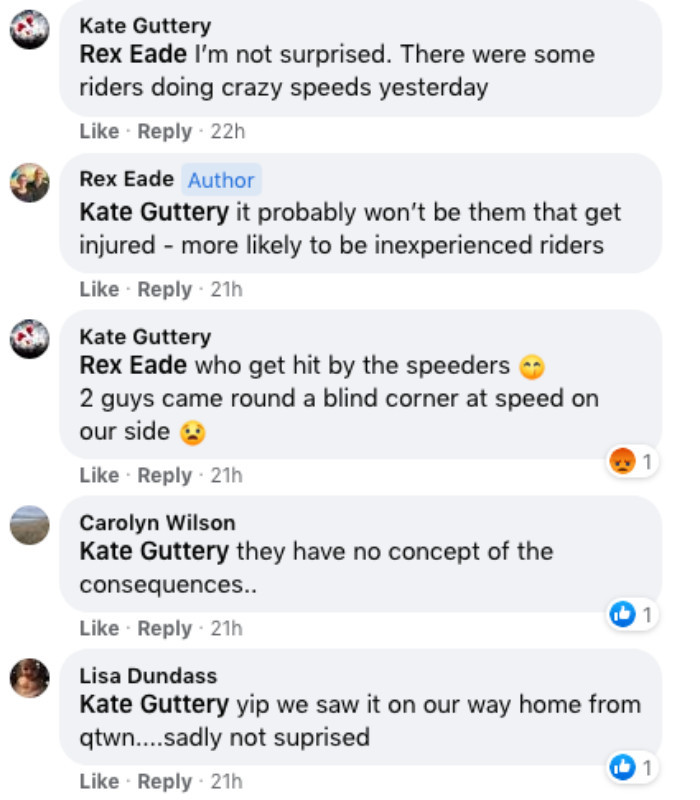Lake Dunstan Trail: Speeding and reckless cyclists
Rowan Schindler
18 May 2021, 6:30 PM
 The Lake Dunstan Trail has been a hit after only a few weeks in operation, however there have been concerns over speeding and reckless cyclists. Photo: Rex Eade/Facebook.
The Lake Dunstan Trail has been a hit after only a few weeks in operation, however there have been concerns over speeding and reckless cyclists. Photo: Rex Eade/Facebook. The opening of the Lake Dunstan Trail has been warmly welcomed and is roundly given rave reviews, however after only a week of being open there has been injuries and concerns over speeding cyclists.
Rex Eade posted an image to Facebook of a rescue helicopter tending to an injured cyclist over the weekend.
“It’s a truly great trail but unfortunately I can’t help thinking this is likely to become a regular sight,” Rex wrote.
A number of social media users commented with “agree” and “watch out!”
Vincent Community Board member Russell Garbutt agreed with the “general gist” of the comments.
“My understanding is that some of the commercial bike firms are advising their clients NOT to use the track on weekends,” he wrote.
“I've biked the track in part several times since the opening day and despite being ultra careful on the blind corners I've had a couple of close encounters.
“The mix of older, less experienced people on eBikes and young gung ho riders requires both groups to be careful, considerate and cautious.”
He continued commenting in the thread, and added, “on the first day, my neighbour measured the vertical metres from Clyde to Cromwell as 939m”.
“There is no doubt at all that the track is challenging but at the same time it’s a huge asset to the region,” Russell wrote.
“I thought it more challenging going from the Cromwell end to Clyde. Easier to navigate the tight switch backs going down than up. But that might be me!”
One commented that two speeding riders came around a blind corner at speed and almost caused an accident.

The Lake Dunstan Trail has sparked debate over speeding and reckless cyclists. Photo: Facebook.
Michele Stainburn said the trail was very busy and rescue teams will regularly be visiting.
“Just rode this amazing trail again today and the first time with two way traffic. It was mayhem, to put it mildly. I agree that the rescue teams will be working overtime!”
Kris Evans said cyclists need to slow down on the shared path.
“Maybe the ones on bikes need to slow it down a bit and respect it. Injuries can be nasty and water unforgiving.”
Melanie Kees said she rode it and did not have a glowing review.
“Rode today (Sunday), won't rush back again on a weekend!
“Traffic was terrible, e-bikes at speed, inexperienced riders, congestion at the coffee place.
“There needs to be some etiquette, the differing speeds (E versus pedal) and poor visibility is going to cause some serious issues.
“The good was the great atmosphere, and enjoyment people were having.”
Annette McLean wrote she was sad to see the helicopter, as well as the comments in the thread.
“I’m sad to see the Rescue Helicopter was needed today and I’ll admit I’m also sad to read the comments.
“What was supposed to the jewel in the Central Otago trails crown appears to already be causing issues.
“With such a narrow track, tight corners, challenging gradients and close proximity to water it was always going to need the riders to take care, respect others and be aware of their surroundings.
“Sadly, this appears to not be the case.”
Sarah Mills said she ran the trail and noticed it was busy but nobody was being reckless.
“I had to stop for people coming over certain parts of the track and people stopped to wait for me to get past them in areas but everyone seemed happy and I wouldn't say there was anyone being reckless.
“Heaps of people out in the sun enjoying this awesome new trail.”
The Central App spoke to Waka Kotahi NZ Transport Agency (NZTA) media manager Frances Adank, who is a lifelong cyclist.
She says she understands the frustration some people have but reinforces the rule that cyclist must give way to pedestrians and be in control of the vehicle (bicycle) at all times.
The NZ Transport Agency is the New Zealand entity tasked with promoting safe and functional transport, including cycling.
She said pedestrians on a shared pathway always get right of way and the cyclist should not expect pedestrians to move.
Instead, the cyclist is the one who must make accommodations for any pedestrians.
Ideally, both should be courteous of one another and share the space.
“We can have all the rules in the world but in many circumstances, people need to take extra care and build in some forgiveness,” she says.
“Many cyclists on a daily commuting basis have to ride as if a vehicle is about to exit a driveway and the driver does not see them, or not give way to them at an intersection where they should do, to stay safe.”
Frances gives a very important example of who gives way to who.
She says with the introduction of e-bikes, more people are using the roads and paths than ever before and some may not be up-to-date on the rules and regulations involved.
“The general rule is that electric (such as e-bikes) gives way to manual (no matter the source eg. e-scooter versus push scooter), cyclists/ pedal power or scooters give way to pedestrians and when sharing the highway, cyclists have to obey the road code like all drivers.”

Pedestrians get right of way on shared pathways but everyone should be courteous and look out for one another and be kind, according to NZTA. Photo: Tourism Central Otago.
To put simply, pedestrians get right of way against anything other than themselves, as they are the most vulnerable user.
When it comes to roads, cyclists are considered vehicles, so motorists have to give them equal measure, especially when encountering them on one-way bridges.
A number of instances have been discussed about rail trail users crossing roads, sometimes without looking out for traffic.
“I think people acknowledge that when going off an off-road path/shared path it may take cyclists a minute to remind themselves of their open road environment so all drivers just need to take care if they can see a trail exiting at a particular point to go across the highway or join it,” Frances says.
“The onus is on the cyclist to obey the road rules and often there will be warning signs reminding them of an intersection ahead or that they are rejoining a highway/ local road.
“But drivers can also keep their eyes open if they are in an area which has shared paths or cycle trails – cyclists are much more vulnerable than a person is inside a vehicle so drivers need to remind themselves of that also.
“We want people to be safe and enjoy shared paths and that means building in care on all sides – be prepared for people to not always do what you think they will do.
“Experienced riders need to be aware not everyone will be a competent, confident cyclist when they start out.
“If people can be courteous and yell out a warning or ring their bell if they are passing without frightening the person ahead, great.
“If people can avoid wearing earbuds if they need to be in touch with their surroundings is another thing to bear in mind.”
Advertisement


